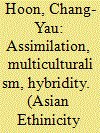| Srl | Item |
| 1 |
ID:
075390


|
|
|
|
|
| Publication |
2006.
|
| Summary/Abstract |
The dominant discourse in accommodating the ethnic Chinese in Indonesia during Suharto's regime was one of assimilation, which forcefully aimed to absorb this minority into the national body. However, continuous official discrimination towards the Chinese placed them in a paradoxical position that made them an easy target of racial and class hostility. The May 1998 anti-Chinese riots proved the failure of the assmilationist policy. The process of democratization has given rise to a proliferation of identity politics in post-Suharto Indonesia. The policy of multiculturalism has been endorsed by Indonesia's current power holders as a preferred approach to rebuilding the nation, consistent with the national motto: 'Unity in Diversity'. This paper critically considers the politics of multiculturalism and its efficacy in managing cultural diversity and differences. It deploys the concept of hybridity to describe as well as analyze the complex identity politics of the ethnic Chinese in contemporary Indonesia.
|
|
|
|
|
|
|
|
|
|
|
|
|
|
|
|
| 2 |
ID:
075392


|
|
|
|
|
| Publication |
2006.
|
| Summary/Abstract |
Using data collected in Lanzhou, this paper examines the effect of minority ethnicity on neighbourly relations in China. It shows that the Hui as a whole express a higher level of satisfaction at relations with neighbours than the Han do. It also shows that the Hui advantage is removed with key background characteristics controlled. Finally, this paper shows intra-group variation among the Hui. These findings suggest that social status is a better predictor of neighbourly relations than the focus on inter-group contrast in traditionality in the existing scholarship of the Hui. Both inter- and intra-group variation in urban life must be examined to attain a more balanced picture of Hui Muslims in China.
|
|
|
|
|
|
|
|
|
|
|
|
|
|
|
|
| 3 |
ID:
075391


|
|
|
|
|
| Publication |
2006.
|
| Summary/Abstract |
The Solon tribes, including the Oroqen, the Ewenk and the Daur, have lived in Heilongjiang (North Manchuria) for millennia. For centuries, the Solon led a hunting life in the mountains and along the rivers. Their constant migration earned them a reputation as nomads. Russian penetration into the region in the late nineteenth century Russified many of the Solon, which alarmed the Chinese government into action. The Chinese persistently embraced every opportunity to win them over. The principal policy adopted by both the Qing dynasty and the Chinese Republic was to turn Solon nomads into sedentary farmers. The government erected villages for the Solon, helped them to adapt to new life, and educated them to be Chinese citizens. These paternalistic yet preferential measures, however, rapidly Sinicized the Solon in just three decades.
|
|
|
|
|
|
|
|
|
|
|
|
|
|
|
|
| 4 |
ID:
075389


|
|
|
|
|
| Publication |
2006.
|
| Summary/Abstract |
The migration of the Nepalis to Northeast India for cattle grazing and dairy farming since the last years of the nineteenth century evolved as a mainstay of later Nepali migrations in the twentieth century. It is significant that this group of migrants enjoyed active colonial patronage, along with the labourers and Gurkha soldiers in the army, but was among the first to face the impact of changing colonial land and taxation policies. Government policies of exclusion and nativist attitudes in post-independence India caused them considerable insecurity about their status in the region. This paper highlights the evolution of the Nepali dairy farmers as an important economic group within the larger group of Nepali migrants in Northeast India, and looks at the issues that led to a redefinition of their relations in the host country and articulations for reassertion/or search for an identity in India.
|
|
|
|
|
|
|
|
|
|
|
|
|
|
|
|